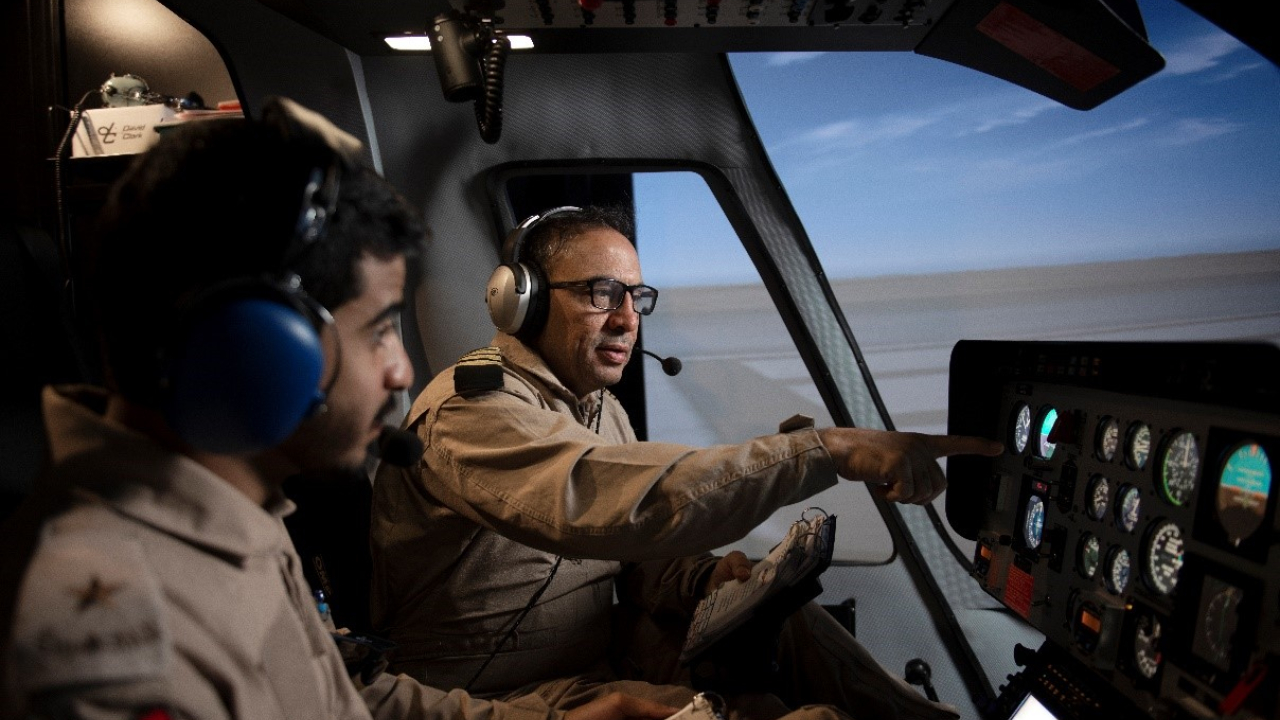Horizon highlights benefits of simulation-based rotary training for pilots
As the aerospace industry seeks to improve pilot training and reduce costs, simulation technology has emerged as a leading method of innovation.

Horizon Simulator. Image: Horizon
One of the most valuable investments in pilot training is the use of flight simulators, which prepare students for the realities and unexpected challenges of flying a helicopter. While gaining experience onboard an actual aircraft is crucial, the ability to encounter and manage difficult situations within the safety of a simulator is invaluable.
Horizon, an entity of EDGE Group, and the region’s largest independent helicopter flight training academy based in the United Arab Emirates, offers simulator training with side-by-side seating cockpit and a complete instrumental panel provided for visual and instrument training.
As a centre for new generation pilots, the company delivers programmes to leading commercial and defence operators with state-of-the-art facilities and a diverse team of experienced instructors.
Flight Simulator Training at Horizon
Most flight simulators feature realistic cockpits, mimic common operations at airports, imitate real-life weather conditions, and provide highly detailed 3D graphics. Some simulators are highly complex and hyper-realistic with a steep learning curve, while others are more straightforward. Although simulators cannot fully replace real-world training, they allow pilots to practice manoeuvres and scenarios that are not feasible in actual flight. Simulator training is particularly beneficial for emergency situations, teaching pilots how to handle emergency landings and other critical scenarios under various conditions, whether day or night. In simulator training, pilots can safely practice dealing with situations such as engine failure and rotor issues while landing or flying.
The Horizon simulator features software that includes over 24,000 airport programs and provides an accurate flight model, incorporating factors such as translational lift, ground effect, and auto-rotation.
The Safest Way to Learn
Arguably, the primary benefit of using simulators during pilot training is the increased safety for both instructors and students. Simulators provide a controlled environment where mistakes are allowed and can be safely addressed. This setup eliminates safety risks while performing and repeating normal and abnormal procedures that might be inappropriate or dangerous for novice pilots. In a simulator, students can make errors, reset, and try again until they master the manoeuvre. They have the opportunity to learn and experiment with aircraft controls and flight methods from the safety of the ground.
Advantages of Simulator Training
Simulator training has several advantages and here are some of them:
Reduced Cost Simulator training helps reduce costs, though there are differences between actual flight hours and simulator hours. Costs such as fuel, maintenance, insurance, and flight instructor fees accumulate quickly when flying a helicopter. As education fees rise and helicopters become larger investments for schools and instructors, finding ways to cut costs is crucial. Reducing flight instructor fees, insurance, and maintenance expenses not only benefits military training academies but also makes pilot training more affordable for students. For instance, students practicing landings in a simulator can quickly reset to a final approach, saving time compared to returning through a real-time landing pattern. This not only reduces time but also eliminates the need for valuable fuel and mitigates the risks associated with inexperienced pilots.
Improve Navigational Abilities In addition to enhancing proficiency with helicopter controls, a simulator offers various scenarios that help improve a pilot’s navigational skills without the risk of actually going off course. This allows future pilots to become familiar with navigation and its related skills without endangering the aircraft or anyone on board. By practicing in a simulator, pilots can explore different navigation techniques and make mistakes in a controlled environment, thus avoiding potential risks and inefficiencies in real-world flight.
Build Substantive Muscle and Technical Skills Memory Pilots also develop substantial muscle memory and technical skills by repeatedly running various scenarios, which helps build a comprehensive knowledge base for future challenges. This is particularly valuable during emergency simulations, as it ensures pilots know exactly how to respond to potentially dangerous situations, minimising hesitation and anxiety when faced with real-life emergencies.
Master Weather Problems During pilot simulation training, pilots are not limited by weather conditions, time of day, or season. Flight simulators allow training in any weather scenario—whether day or night, rain or shine—enabling students to learn how to efficiently and safely control a helicopter in various conditions. This capability allows pilots to master weather-related challenges without having to wait for specific weather patterns like rain or snow. It is especially beneficial for those who train in a single climate, such as a desert. Versatility is crucial for becoming a skilled rotary pilot as many go on to work in military or search and rescue roles where they must handle complex situations and diverse topographies.
Develop Radio Skills Through simulation training, students can also refine their radio communication skills, practice speaking with air traffic control, and learn effective ways to interact with other pilots. This training allows them to rehearse the correct order of operations at the start of their flight. When they eventually take to the skies, they will be well-prepared with the communication skills needed for a safe journey, reducing risks and ensuring optimal radio proficiency.
Prepare for Emergencies Pilots can practice emergency and combat procedures in a simulator without the pressures of real-life high-stress situations. In simulator sessions, students will learn how to handle potential high stress situations, conduct emergency drills, and manage engine fires without experiencing these scenarios in actual flight.
Cost-effective and environmentally friendly, simulators represent the future of rotary flight training. As educational tools, they enhance training benefits and efficiency, help avoid training accidents, and reduce the risks associated with helicopter operations. Rotary flight simulation training provides access to all weather conditions, offers an extensive range of training scenarios, and includes special manoeuvre practice, all within a safe and progressive learning environment.
Stay up to date
Subscribe to the free Times Aerospace newsletter and receive the latest content every week. We'll never share your email address.

